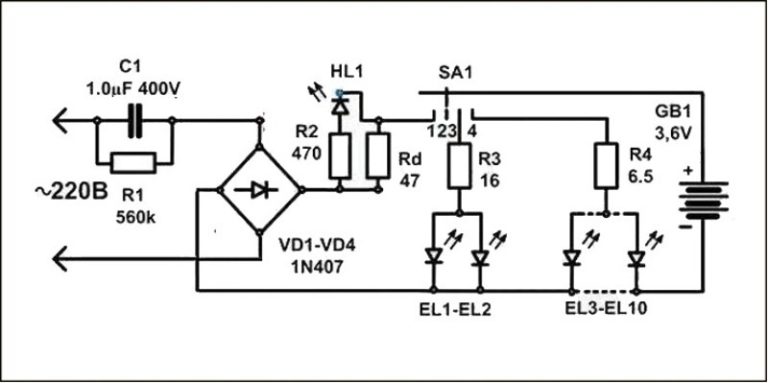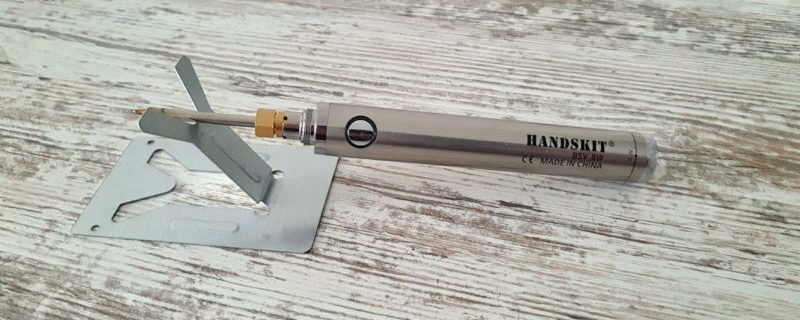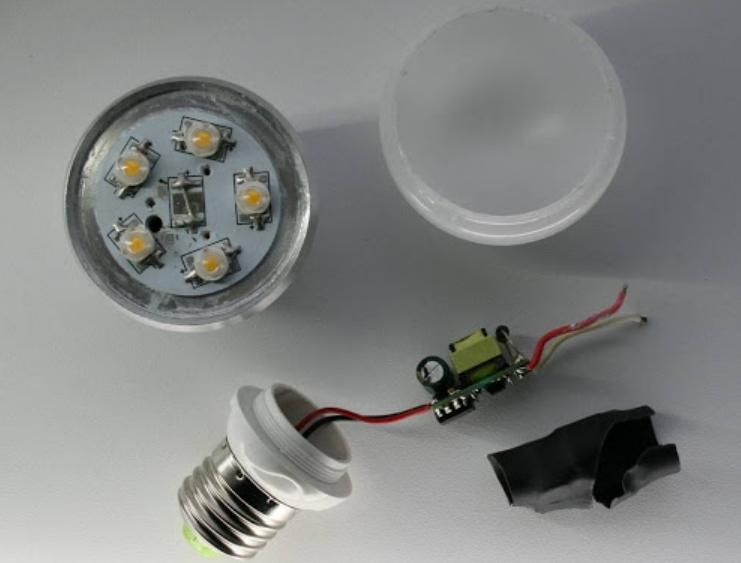How to repair LED light fixture yourself
To repair LED lighting fixtures, you do not need to be qualified as an electronic engineer and buy expensive equipment. The work is not difficult to organize and at home, if you prepare everything you need and understand the peculiarities of the device fixtures. The main thing - do not rush and do everything carefully, following the recommendations from the article.
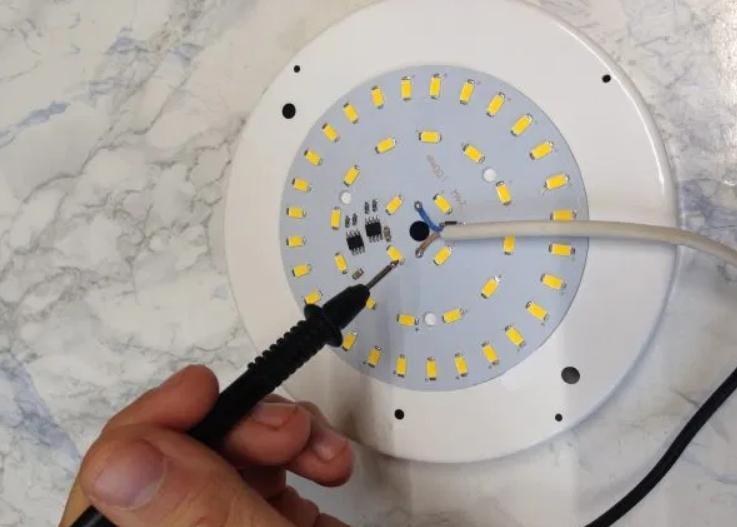
What to do if the LED lamp is broken
These days, on store shelves there is a huge amount of lighting equipment made using diodes. The cost has become affordable, moreover - a lot of cheap options. For all their pluses, they are unreliable and fail very often, especially if there are surges in the mains voltage and power outages.


After a breakdown, check the equipment first. If it shows signs of melting, it probably cannot be repaired. Also, products with physical damage are not repairable. If they have been dropped or broken, it is easier to throw away the lamp than to repair it. It is important to turn off the lamp or chandelier at the first signs of malfunction, in this case the probability of successful repair is several times higher.
Is it possible to repair at home
Repair of LED lights and lamps - the work is not difficult, if you understand the peculiarities of the design. The process is simplified by the fact that the device of all varieties is the same, they consist of the same components:
- The body of the luminaire. The load-bearing part of the design, which contains all the main parts. Can be of different shapes and sizes, it all depends on the model. Is made most often of plastic, but can also be metal. If we talk about light bulbs, there is a ceramic, heat-resistant plastic or metal base. There are different types of bases, it all depends on the standard.
- The driver. The main working unit, which is responsible for power, compensates for voltage spikes and converts the AC current into DC, feeding it to the LEDs. There are two options - capacitor, which are cheaper and used in budget models, and electronic, they are more reliable, but more expensive. The equipment is designed for temperatures from -40 to +70оC, has a good efficiency, but at the same time is the most vulnerable part of the design.
- Mounting board. It carries LEDs and other necessary operating units. Most often it is made of aluminum, a durable material that is good at dissipating excess heat.
- Diodes give the light flux. The more of them installed on the board, the brighter the lamp or bulb. The most common are PSBs and SMD chips.
- There are wires from the driver to the bulbs, and they can be soldered or connected by terminals. Depending on the brand of chandelier and the functions available to it, one bulb can have from 1 to 12 wires.
- If the chandelier is remotely controlled, it will have an antenna, control unit, voltage regulator and modules responsible for automatically adjusting the equipment.

Accessories may vary. For example, in low-cost lamps, they put power supplies of the capacitor type without transformers. They serve as a current and voltage limiter. Ideally, it is better to find a manual with a diagram of the luminaire, it is usually on the package or on the insert sheet.
Types and main causes of failure
If there are problems with the LED lamp or bulb, it is impossible not to notice. Failure options can be different, but the most common are the following:
- The light completely disappears. This can happen either when you turn it on or off, or during operation.
- The light can disappear at any time and resume after some time. And the time intervals can be anything.
- Flicker of a light bulb or fixture. The intensity may vary, but the change in brightness creates discomfort for vision.
- Blinking - when the light blinks every second.
- Damage to the structure due to impact or moisture in the system (for example, due to condensation or if the upstairs neighbor flooded the apartment).
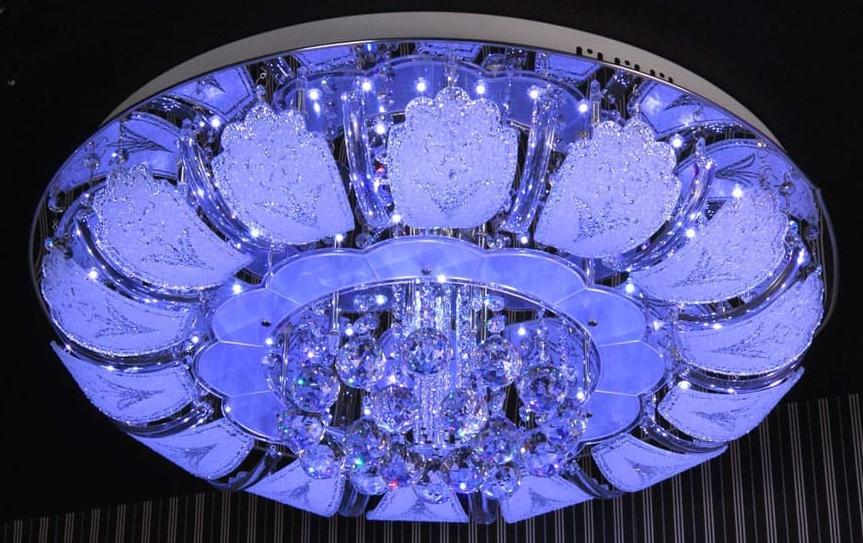
If there are only a few types of faults, there are many more reasons. The most common problems are:
- Overheating of the nodes and their deformation or violation of contacts. Diodes do not heat up much (about 30 degrees). But if the room is hot, the temperature under the ceiling can rise to 50-60 degrees, and under these conditions, the contacts are broken, parts fail and separate elements on the board delaminate. The problem also occurs when the cooling radiator becomes covered with dust over time, or the lamp is located in a place with poor ventilation.
- Violation of the recommended rules for use of LED equipment. Together with the luminaire and chandelier always come with operating conditions under which the manufacturer guarantees long life. Any deviations increase the risk of malfunction by many times.
- Diode burnout caused by voltage surges or capacitor failure. This is typical for inexpensive models.
- Various violations during connection and installation of the equipment. Short circuits and other malfunctions of the network can be the cause of failure.
Important! The cheaper the product used, the higher the probability that even the slightest deviations from the norm will lead to malfunction.
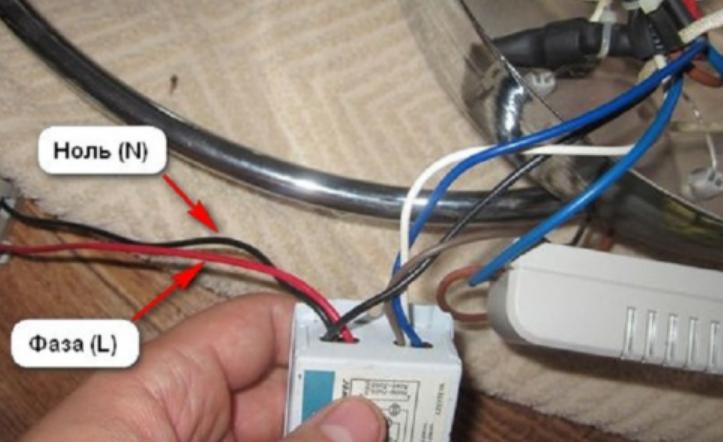
Do not forget about the factory defect, it is much more common than in other varieties of lights. Especially often there are defects in the lamps with remote control, because the design is complex, and the technology is often not yet perfected to the end.
Preparing for repair and what it will take
It is necessary to prepare everything you need for the work. Some items may be on hand, others will have to buy, but it will not cost much. List of tools and appliances:
- A small soldering iron with a small sting. The contacts in the lights are shallow, so a standard version will not do. It is best to buy a special model with different types of tips (flat and point). Do not forget about the materials for soldering - solder, rosin, etc.soldering iron with a thin tip and usb charger
- A set of tweezers. The tool store sells a set of tweezers for small jobs, they have the right shapes and sizes.
- A holder for a lamp or other assembly (the so-called "third hand"). A good solution is a fixture with a magnifying glass to simplify the work. You can adapt the elements at hand - cut off a plastic bottle or pick up something else.
- A small gas burner. Models from tobacco kiosks, which are used to light cigars, will do. If you can't find such a device, buy a so-called "turbo lighter" that does not go out in the wind.
- A set of screwdrivers of various sizes to remove and disassemble the lamp. Most often Phillips head screws are used as fasteners.
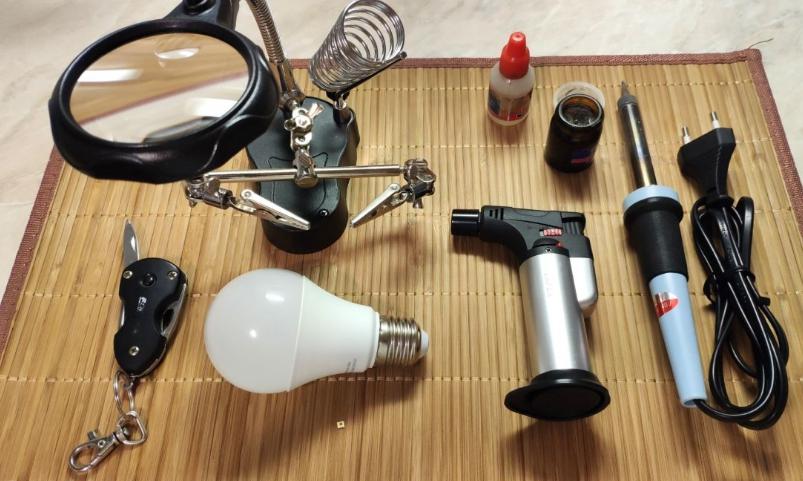
Some fixtures use hex head screws, so a set of wrenches may also be required. Repairing LED lights is a meticulous job, because the products have many small parts, and if handled carelessly, you can damage them.
How to repair with your own hands
Repair of diode lights will allow you to save significant money, because in the workshops most often for this work take half the price of the equipment. Light bulbs are also realistic to do, if you have the right spare parts on hand.
Luminaire
Ideally, you should have a diagram of the equipment on hand, so when you buy it, you should find it (on the package or in the instructions) and save it so it doesn't get lost. This will greatly simplify the work and help you understand the design much faster. Variants without remote control are much easier to fix, you have to remember these recommendations:
Remember! Before you start work, disconnect the power supply in the switchboard.
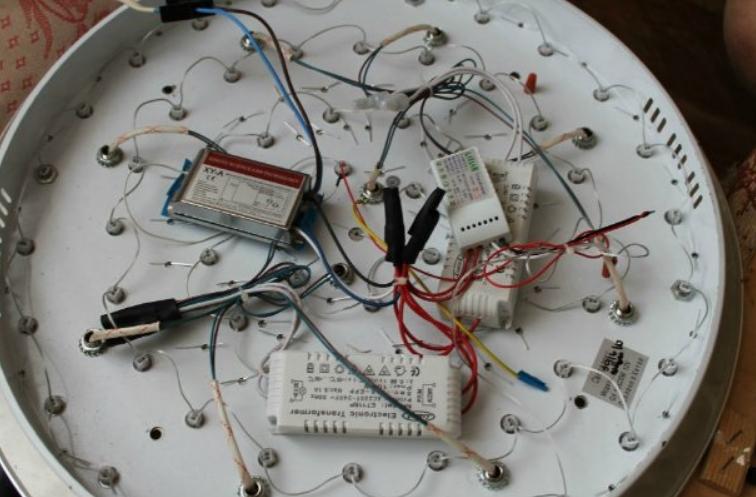
- Remove the light fixture from the ceiling, first disconnecting the contacts. If there is a lot of dust on the top, you need to carefully remove it so that during disassembly no debris gets inside. Next, you need to disassemble the case to open access to the internal elements.
- Carefully examine the parts for damage and defects from overheating, especially contacts and connections. Often it is because of them that problems arise. Repack the terminals, as well as the twists, tighten the screws.
- If no problems were found, go to the inspection of the lamps or blocks, if the relays and LEDs are on the same board. Connect the block at 12 or 24 V (depending on the nominal value of the elements), and wire all the LEDs with signs of damage or malfunction.
- You can do something simpler - plug the light module into the mains through the power supply and short-circuit the contacts on each LED in turn. Do this until the lamp lights up, when the burned element will be found.
- Replacing the LEDs in the lights is done only with elements of the same rating, so it is better to order them in advance, as there can be problems with the acquisition. If you install a jumper in a system that includes less than 10 light elements, the capacitors will fail due to overloading. Ideally, do not use jumpers at all when repairing, but if the board consists of several dozen diodes, you can close the contacts of one with a piece of wire, having previously removed the old element and cleaned the fouling.
- If there is nothing wrong with the LEDs, the board is checked for burnouts, continuity of the tracks. It is also worth inspecting the capacitors, if they are darkened or bloated - they need to be replaced. Due to overheating of the matrix contacts can be broken, they should also be checked carefully and soldered all of them, where there are doubts.
- If you find damage in the control unit, it is worth replacing it with a similar one. Pay attention to the characteristics of the part, do not mix up the wires when connecting.
- Before installing the board in place it is necessary to renew the layer of thermal paste, if it was in the place of adjoining the cooling radiator. Carefully wipe the old one with a damp cloth, degrease the surface, apply a thin layer of new compound, distributing it evenly.
For your information! You can buy thermal paste at any computer store.
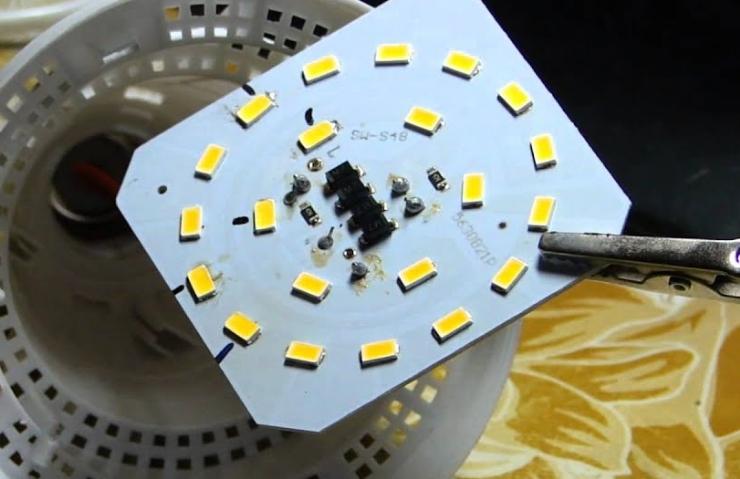
It is not difficult to repair a chandelier if you understand how it works. Most often, the problem is in the burnout of the LEDs, because they are connected in a linear fashion and when one element fails, the circuit is broken. On the same principle, it is worth looking for malfunctions in strip lighting. If the inspection does not reveal a burned element, you will have to ring everything in order.
Video: Repairing a 36 watt LED ceiling light.
LED bulb.
When a standard lamp fails, the ways of troubleshooting are not different from the variant described above. But there are peculiarities that are worth considering. To find the problem and quickly fix it, you need to follow these instructions:
- First, you need to make sure that the problem is in the bulb. To do this, unscrew the faulty one from the socket and put the working one in its place. If it does not light, then the problem is in the power supply. Inspect the contacts in the socket. If they are dark, it is likely that the fault is a loose fit, you need to clean the surface from carbon deposits, bend the tendons. It may also be the fault of the lamp socket or a broken switch.
- If the test light comes on, proceed to repair the first one. First you must remove the diffuser, most often it is held by a thin layer of sealant, so if you carefully turn the connection, you can tear the element from its place. If it holds, use a thin screwdriver to squeeze the connection in several places. When this method does not help - warm the joint with a hair dryer, it usually provides trouble-free removal.The main thing is not to damage any parts while disassembling.
- On the pad under the diffuser is fixed board with LEDs, it must be removed. To do this, first remove the screws that hold the part, and then separate the contacts on the board. It is necessary to take hold of the wire with tweezers, and melt the tin with a soldering iron, gently straighten the end to extract it later, do the same with the second contact. Remember the location or color indication on the insulation so as not to mix up the wires.
- Remove the board and inspect it. Usually a burnt LED can be seen immediately by the dark dots or soot on the back side. But to be sure, you should test the circuit with a tester. Sometimes two elements burn out, if this is not found out at once, you will have to redo the job twice.
- If all the LEDs are okay, most likely the driver, which is located under the board in the lamp housing, failed. You need to buy one or take one from the same lamp.
- In the case of a burned out LED, you should properly remove it. The board is fixed in a holder or in any way so that it is accessible from both sides. Tweezers should be clamped to the damaged element, and a gas torch is used to heat the board from the back side at the junction for 2-3 seconds. Pull the tweezers towards yourself to remove the diode, do everything carefully.
- Replace it with a LED with the same characteristics. First, carefully apply a little solder with flux on the place of installation, or lubricate the contacts with acid. Install the LED correctly (a large contact is always a minus), warm the board for 2-3 seconds with a torch and gently press the diode so that it falls into place. Wipe the cooled connection with alcohol.
- It is best to wipe off the thermal paste from the surface of the heatsink and apply a new one. Next, carefully place the board by sliding the wires through the holes, then solder them in place and tighten the retaining screws. Check the operation of the light bulb. If it doesn't work, test the LEDs again.
- Remove any old adhesive residue from the light, if any. Apply a thin layer of silicone sealant, press the elements together and leave to dry for a few hours.
Tip! It is best to find the same faulty light bulb to take the necessary parts from it.
It is easier with light bulbs than with lamps, as their construction is always the same. Repair is not difficult, the main thing is to do everything carefully, do not overheat the board with a torch and observe the polarity of the diodes when soldering. There are no other requirements.

More details in a separate article: How to repair an LED light bulb yourself
Troubleshooting remote-controlled light fixtures
This type of chandelier is much more complex than conventional models, so you need to repair it differently. If the equipment does not turn on, first of all it is worth replacing the batteries in the remote control, often this is the problem. If the replacement of the batteries did not produce a result, then carry out the repair in the following way:
- Carefully remove the chandelier from the ceiling and prepare it for inspection. First, pick up a power supply with a suitable voltage and connect to the contacts, then turn on the equipment with the remote. If it works, you should look for the problem in the wiring. When the chandelier does not turn on, but you hear a slight clicking sound, the controller is likely to be faulty.
- It is easy to check the driver by disconnecting it from the controller and applying voltage directly. If the lamp worked, then the problem is in the controller. When the light does not appear, you need to buy a driver. They have about the same characteristics, the main thing is to consider the number of control channels.
- When there is no driver, and you need to use the chandelier, you can disconnect the wires of the lamps and drivers and connect them directly to the terminal block. Then you will use the equipment from a standard switch on the wall.
- Search for other faults should be carried out in the same way as described above, there is no difference in replacing the LEDs.

If the remote does not work, only its replacement will help.
Repair of LED lights with their own hands on the power of anyone who understands the simplest circuits and is able to use a soldering iron. The main thing is to be careful and not to use parts that do not match the characteristics of those that failed.
